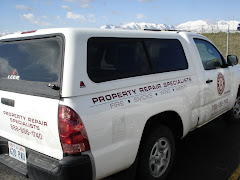
I was recently visiting Melissa Felis's State Farm office in Salt Lake City and discovered that the back yard of their office, which is a converted home, is a wonderful vegetable garden. Melissa has donated the space behind her office to the residents of The Canyon Creek Assisted Living Center, and every week they come to work in the garden and take home some of the wonderful vegetables.
Melissa had the idea for a co-op garden, but said she doesn't have gardening skills. Eventually, one of her clients, offered to help her do the gardening. His wife works for the center and suggested the idea to have the residents garden as a weekly activity. Melissa wanted to give something back to the community, providing seniors and others who need food to have it provided. She believes in paying it forward. If you take something from the garden, she just asks you to do a little work in it! This is the garden's first year and will be continued next year.Seeing the garden in its peak got me thinking about the benefits of such gardens.
I have never been into gardening but the idea of a vegetable garden just seems marvelous. Having been a long-time beneficiary of my aunt’s garden, I recognize great- tasting fresh garden peas and heirloom tomatoes. I decided to see what it takes to manage a great garden, and with what I learned, I will be ready to plant at the first signs of spring.
I have a small yard and not much room for a big garden, but the amount of land devoted to a vegetable garden will return more than you could ever imagine. If you don't have a lot of space to devote to a vegetable garden, make a three foot by three foot grid and plant a different crop in each square foot. If space is limited you can grow some crops in large pots on a deck or patio.
A garden should be well planned in advance. Choose the sunniest spot in your yard, avoiding any areas that are too shady. Decide if you are going to plant in open soil or in raised beds. If planting in raised beds, they should be three to four feet wide and eight to 12 inches high and however long your space will allow. You can either pile the soil or enclose the beds in wood or stone frames. You can either pile the soil or enclose them in wood or stone frames. Open soil is perfectly fine for planting. Raised beds often allow the soil to warm quicker, therefore planting can begin sooner.
Get your soil ready with all the right nutrients. Mix in compost or well rotted manure, even if you are adding new top soil. Utah soil tends to lack nitrogen and phosphorous elements, apply three pounds for every 100 square feet of 10-20-0 fertilizer to supplement this deficiency.
Utah gardens can grow all sorts of vegetables. Broccoli, cauliflower, corn, eggplant, kale, asparagus, beans, tomatoes and all sorts of herbs are all grown in gardens across Utah. For information on planting and harvesting different crops, here is a chart from Utah State’s extension services:
Planting and Harvesting various crops
If you have an existing garden, fall is the time to do some early maintenance before the freeze. Remove dead and spent plants. If you want to get an early start on next season’s harvest, you can plant some vegetables now so they mature sooner in the spring. Timing is everything September is a good month to plant onions, carrots and spinach for next summer's harvest. Add some nutrients and cross your fingers.
For more information on gardening or joining a local community garden, check out the following site:
American Community Garden Association-Find your own community garden




